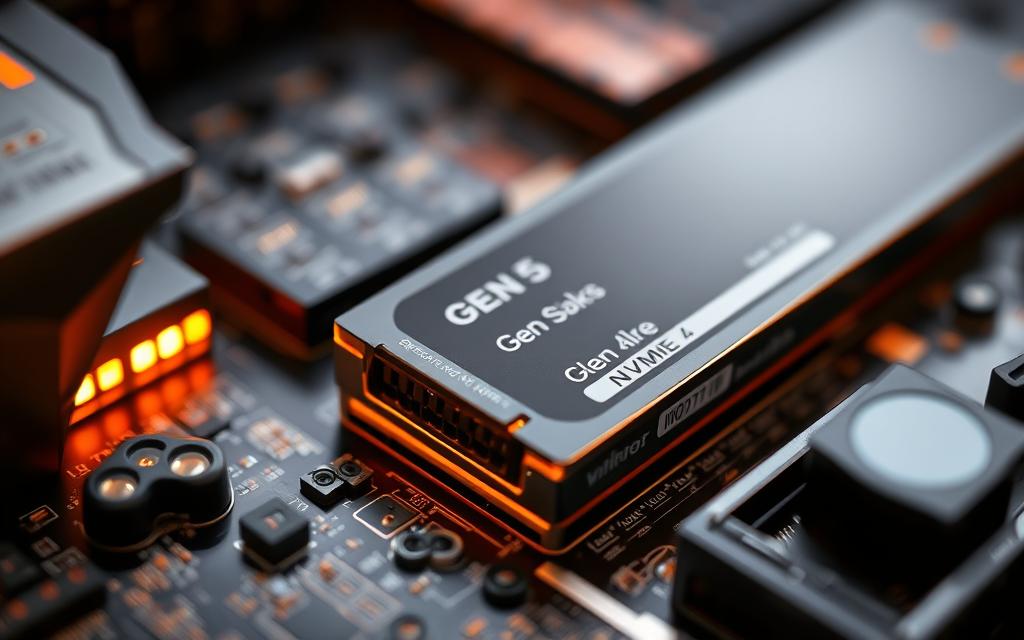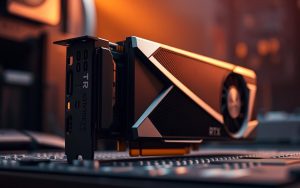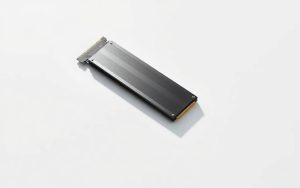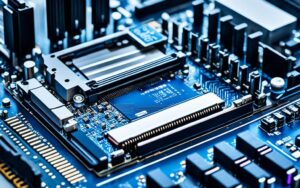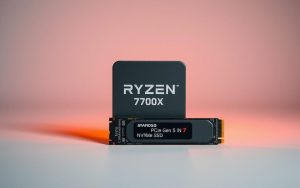Table of Contents
Upgrading storage often raises questions about backward compatibility. PCIe generations maintain physical consistency, allowing older drives to fit newer slots. The standardized M.2 interface ensures Gen 4 SSDs work in Gen 5 motherboard slots without modification.
Performance, however, depends on the drive’s native specs. While a Gen 5 slot supports higher bandwidth, a Gen 4 SSD won’t exceed its read/write limits. Real-world speed gains depend on workloads—gamers may see minimal impact, while content creators benefit from sustained transfers.
Hardware limitations also play a role. Some CPUs, like Intel’s 12th/13th Gen, allocate limited Gen 5 lanes. For deeper insights, explore discussions on PCIe generation compatibility.
Understanding PCIe and NVMe Generations
Modern storage solutions evolve rapidly, creating confusion about hardware interoperability. PCIe generations and NVMe protocols dictate performance ceilings, but physical compatibility remains consistent across versions. This section breaks down how these technologies interact.
How PCIe Generations Affect NVMe SSDs
PCIe lanes determine data throughput. Most NVMe drives use x4 configurations, meaning four lanes handle transfers. Each generation doubles bandwidth per lane:
| PCIe Generation | Bandwidth per Lane (GB/s) | Total x4 Bandwidth (GB/s) |
|---|---|---|
| Gen 3 | 1 | 4 |
| Gen 4 | 2 | 8 |
| Gen 5 | 4 | 16 |
While PCIe 4.0 drives cap at 8GB/s, Gen 5 slots support 16GB/s. Real-world gains depend on workloads—sequential tasks like video editing benefit most.
The Role of NVMe Protocol in Compatibility
NVMe SSDs optimize performance via parallel queues, reducing latency. Protocol versions (1.4 vs. 2.0) enhance features but don’t alter physical compatibility. For example:
- NVMe 2.0 supports 16GB/s transfers but requires PCIe 5.0 hardware.
- Older drives default to their native speeds in newer slots.
Kingston’s FURY Renegade hits 12GB/s in Gen 5 setups, showcasing the potential of matched hardware.
Can I Use Gen 4 NVMe in Gen 5 Slot?
The M.2 form factor simplifies NVMe SSD installations across PCIe generations. Identical physical dimensions and keying ensure seamless integration, whether using older or newer drives.
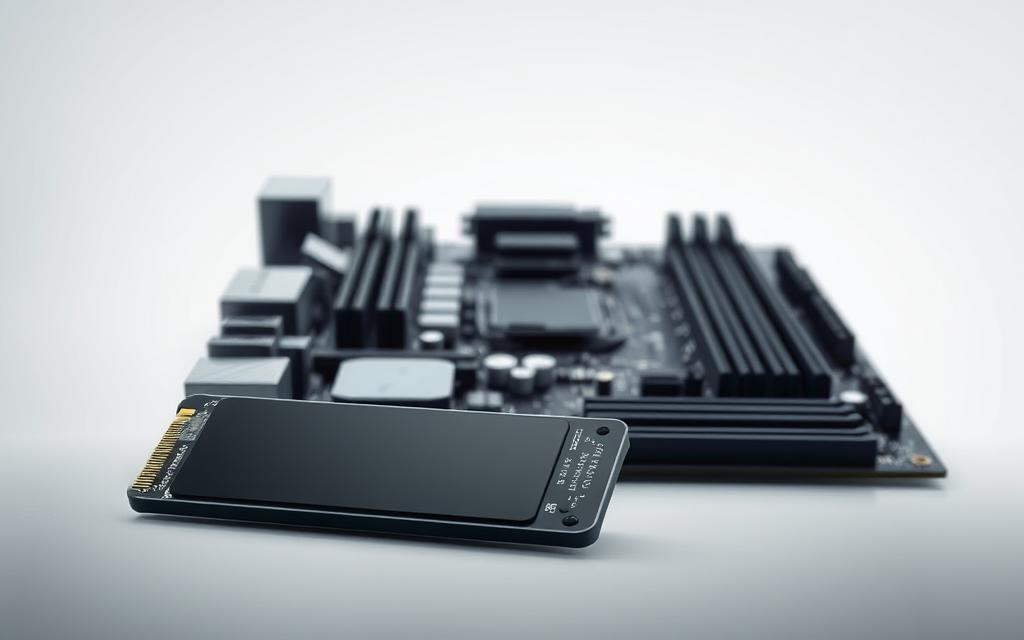
Physical Design and Thermal Considerations
M.2 2280 SSDs share standardized notches (M+B key) for universal fit. However, Gen 5 slots may expose Gen 4 drives to higher temperatures due to increased power delivery. Active cooling solutions are recommended for sustained workloads.
| M.2 Version | Key Type | Max Bandwidth |
|---|---|---|
| PCIe 4.0 | M+B | 8 GB/s |
| PCIe 5.0 | M+B | 16 GB/s |
Firmware and UEFI Configuration
Motherboards like Intel’s Z690/Z790 may require BIOS updates for stable Gen 5 operation. Critical checks include:
- SSD controller firmware revisions
- UEFI settings for manual PCIe version locking
- Windows 11’s automatic link-speed negotiation
Intel’s LGA1700 platform limits Gen 5 lane allocation, affecting multi-drive setups. Always verify CPU specifications before upgrading.
Performance Implications of Mixing Generations
Storage performance varies significantly when mixing PCIe generations. While backward compatibility ensures functionality, bandwidth ceilings and thermal constraints alter real-world efficiency. Below, we dissect how mismatched hardware affects workflows.
Bandwidth Differences: Gen 4 vs. Gen 5
*PCIe 4.0* drives in Gen 5 slots operate at half the potential speed of native hardware. Sequential tasks like video editing suffer most, with render times increasing 30–40%. Key metrics:
| Task Type | Gen 4 SSD in Gen 5 Slot | Gen 5 SSD in Gen 5 Slot |
|---|---|---|
| Sequential Read | 7.5 GB/s | 14 GB/s |
| Random 4K Q1T1 | 85 MB/s | 92 MB/s |
| Thermal Throttling | 65°C (peak) | 72°C (peak) |
Real-World Speed Reductions
Synthetic benchmarks like CrystalDiskMark show stark read/write drops, but everyday impacts differ:
- Gaming: Load times in *Forza Horizon 5* differ by 0.3s (2.1s vs. 2.4s).
- Content Creation: 4K exports take 12 minutes vs. 8 minutes on matched hardware.
- Thermal Risks: Gen 5 slots may push Gen 4 drives beyond 70°C during sustained transfers.
For balanced performance, DRAM cache SSDs like the WD Black SN850X mitigate *latency* spikes. Always monitor temperatures during heavy workloads.
CPU and Motherboard Limitations
The interplay between CPU lanes and motherboard design dictates NVMe performance ceilings. While physical compatibility is guaranteed, bandwidth and latency depend on how PCIe lanes are allocated. Modern platforms like Intel’s 13900K and AMD’s X670E handle this differently.
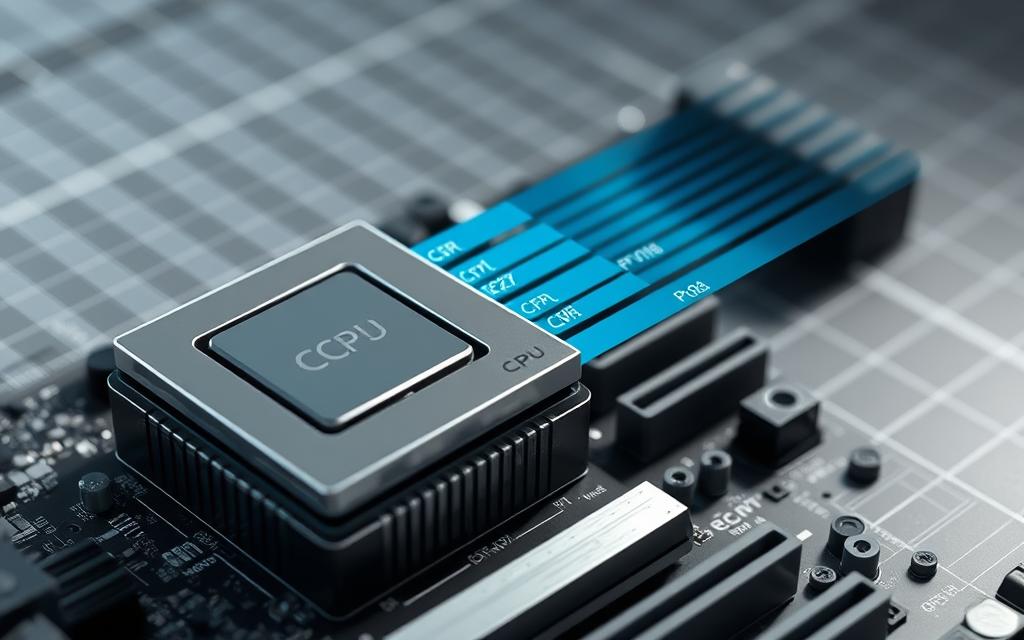
How CPU Lanes Impact NVMe Performance
Intel’s 13900K reserves 16 Gen 5 lanes for storage or GPU, plus 20 Gen 4 lanes. Multi-drive setups force tough choices:
- Two Gen 5 drives split x8 lanes each, halving bandwidth.
- Adding a Gen 4 SSD via chipset adds 500ns latency.
| Configuration | Available Lanes | Max Bandwidth |
|---|---|---|
| Intel 13900K (1 Gen 5 SSD) | x16 CPU-direct | 16 GB/s |
| Intel 13900K (2 Gen 5 SSDs) | x8 each | 8 GB/s per drive |
| AMD X670E (1 Gen 5 SSD) | x4 CPU-direct | 16 GB/s |
Chipset vs. Direct CPU Lanes
Motherboards route PCIe lanes through the chipset or CPU. Direct connections offer lower latency but limit expansion:
- Chipset-routed slots share DMI bandwidth (∼4 GB/s).
- GPU slots downgrade to x8 if multiple Gen 5 drives are used.
For RAID arrays, check motherboard manuals for bifurcation support. AMD’s X670E avoids GPU compromises by dedicating lanes.
When Should You Upgrade to Gen 5?
Choosing the right storage upgrade depends on workload demands and budget constraints. While PCIe Gen 5 delivers unmatched speed, its 2.5x cost premium over Gen 4 requires careful evaluation.
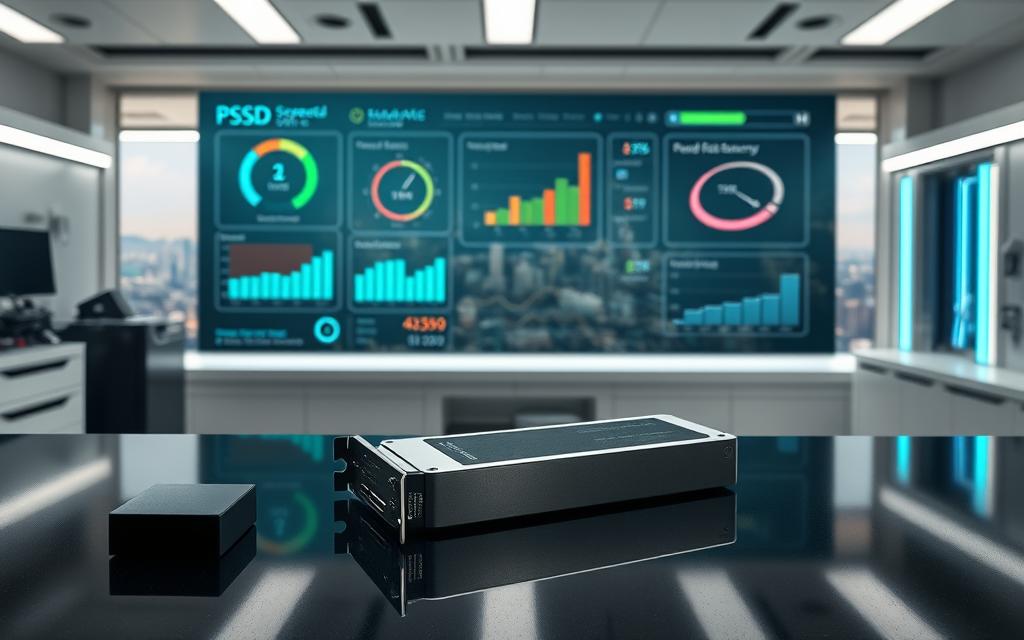
Workloads That Demand Next-Gen Speeds
Three professional groups benefit most from SSD upgrades:
- 8K video editors: Unreal Engine 5 shows 22% faster asset streaming
- AI researchers: Large dataset training times drop 18-25%
- Database administrators: Query response improves by 30%
For these users, the MSI Spatium M570’s 10,000 MB/s read write speeds justify its price. Content creation benchmarks reveal a 12-minute 4K export vs. 8 minutes on matched hardware.
Evaluating Cost Versus Performance
| Metric | WD Black SN850X (Gen 4) | MSI Spatium M570 (Gen 5) |
|---|---|---|
| Price per TB | $90 | $225 |
| Sequential Read | 7,000 MB/s | 10,000 MB/s |
| Power Efficiency | 5W/TB | 5.5W/TB |
Gamers see minimal gains – load time differences average 0.3s. The 98% of Steam games showing
Future-proofing considerations like DirectStorage 1.2 support may sway power users. Early tests show 40% faster texture loading when paired with PCIe gen 5 hardware.
Conclusion
Future-proofing drives requires understanding generational trade-offs. PCIe Gen 5 slots fully support older SSDs, but speeds cap at the drive’s native limits. Thermal demands rise in newer slots, demanding active cooling for sustained *workloads*.
Upgrade decisions hinge on use cases. Professionals handling 8K video or AI datasets benefit from PCIe Gen 5’s bandwidth. Most users find Gen 4 SSDs cost-effective, with minimal real-world gains in gaming or office tasks.
Early adopters face premium pricing and stricter cooling needs. Market shifts suggest Gen 5 dominance by 2026-2027 as prices drop. For now, balance performance needs against budget constraints.
FAQ
Will a Gen 4 NVMe SSD work in a Gen 5 M.2 slot?
A: Yes, PCIe standards are backward compatible. A Gen 4 NVMe drive will function in a Gen 5 slot but operate at Gen 4 speeds.
Does mixing PCIe generations impact gaming performance?
For most games, no. Current titles rarely saturate Gen 4 bandwidth. The difference in load times between Gen 4 and Gen 5 is minimal.
Are there thermal concerns when using Gen 4 drives in Gen 5 slots?
Gen 5 slots often have better cooling, but Gen 4 SSDs run cooler than Gen 5 models. No extra cooling is typically needed.
Will my motherboard automatically detect a Gen 4 drive in a Gen 5 slot?
A: Yes, modern motherboards like ASUS ROG or MSI MEG series auto-negotiate PCIe versions. No manual configuration is required.
Do I lose any features by using a Gen 4 SSD in a Gen 5 slot?
Only bandwidth is limited to Gen 4 speeds. All NVMe features like TRIM and SMART monitoring remain fully functional.
Should I upgrade to Gen 5 if I already have a fast Gen 4 SSD?
Only for specialized workloads like 8K video editing or high-frequency trading. For general use and gaming, Gen 4 drives like the Samsung 980 Pro still deliver excellent performance.
Can I use multiple Gen 4 NVMe drives in Gen 5 slots without performance loss?
A: Yes, but check your CPU’s lane allocation. Some processors may reduce bandwidth when multiple M.2 slots are populated.


